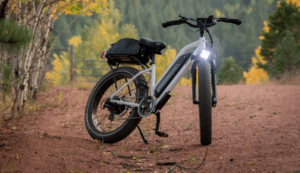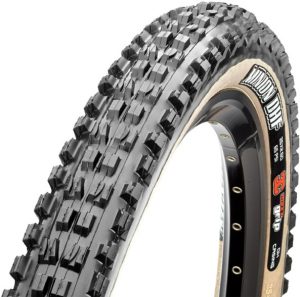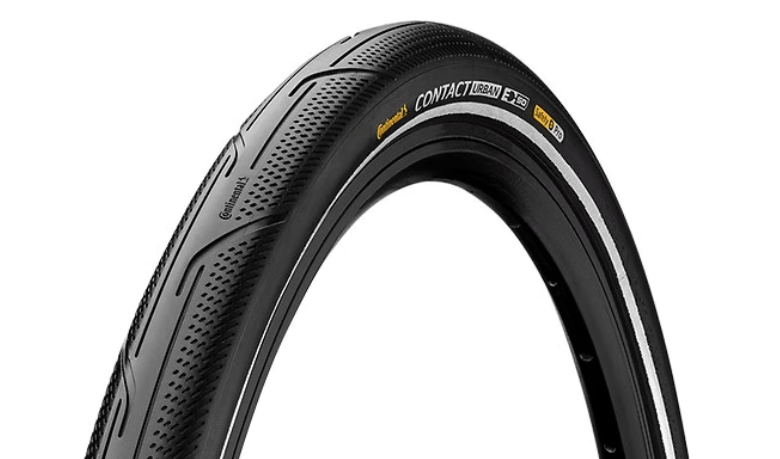Jim is an accomplished triathlete and endurance cyclist, and has raced in more than 35 USAT-certified races. He is also an avid trail runner and endurance gravel bike rider. Jim is a founder of Complete Tri and frequent writer on triathlon and cycling.
E-bikes have exploded in popularity. As e-bikes get used more and more, their tires can wear, which requires some knowledge of which are the best e-bike tires to use as replacements.
Selecting the right e-bike tire depends heavily on your riding type and the terrain the bike is used on. Urban riders might prioritize smooth rolling tires for city streets, while off-road enthusiasts might look for tires with aggressive tread patterns for better grip and stability. Regardless of the type of riding e-bike tires need to be able to handle the additional weight and speed that come with e-bikes.
E-bike tires can experience more wear due to the motor’s torque and the overall increased weight of the bike. It’s important to regularly check tire pressure, tread depth, and overall condition to be sure your tires are always ready for the next adventure.

Types of E-Bike Tires
There are a few main types of tires to choose from, and part of it depends on your wheel’s rim and which type of tire it can handle. Beyond that, I focus on durability and compatibility with electric-assist speeds.
Tubed Tires
Tubed tires are the traditional tire design you find on many bikes, including e-bikes, and are often referred-to as clinchers. These tires contain an inner tube that holds air andmaintains pressure. They are generally more affordable and easier to repair or replace if punctured. Most people who have been road bike riders are very familiar with the clincher-style bike tires.
Pros
- Cost Effective
- Easier to repair: At least once you learn how
Tubeless Tires
Tubeless bike tires have become a favorite of cyclists over the past few years, and eventually will be the industry standard in my opinion. With tubeless tires, you are going to benefit from a reduction in punctures due to no inner tube being present. These tires let you ride at lower tire pressures, which can improve traction and ride comfort in many situations. Their self-sealing capability when punctured is great, as long as you carry some sealant with you.
Pros
- Puncture Resistance: Higher resistance due to no pinch flats caused by tubes
- Performance: Lower pressures enhance grip and ride comfort on varied terrains.
A proper sealant and tubeless-ready rims are essential to maintain the integrity of these tires.
Solid Tires
Solid tires, also referred to as airless tires, are entirely puncture-proof. I recommend them for riders who prioritize minimal maintenance and who will not be riding long distances. However, the ride quality is not as good as air-filled tires, so I don’t like them for longer touring rides.
Pros
- No Flat Tires: Complete elimination of flat tires and need for maintenance.
- Durability: Typically last longer than their pneumatic counterparts.
Solid tires require a compatible e-bike frame and wheels, as they can be harder to install due to their rigidity. Only use them if you really need a tire that requires zero maintenance.
Understanding Bike Tire Dimensions
Tire dimensions can seem like a foreign language to newbies. Don’t get overwhelmed, just focus on a few things. First, your rim, or wheel, dictates what tire you can use. Second, pay attention to width and diameter, as these are critical to performance and ride quality.
Tire size is typically noted in a format such as 700x35C—700 representing the nominal diameter in millimeters, and 35 the width in millimeters, while ‘C’ refers to the tire width code. As the tires get larger, they jump to being measured in inches – like 2.5 inch tires. This is a relic to the world of road bikes (which measure in centimeters) and mountain bikes (which measure in inches).
The rule of thumb: Wider tires can be ridden at lower tire pressures, which makes them more comfortable on rough terrain and gives them more traction in loose surfaces, mud, sand, or snow. Skinnier tires are superior on pavement and flats, due to having less draft, but because they need to be ridden at higher pressures, they can feel stiff.
For older e-bike riders, I suggest using a wider tire as opposed to a narrower one. Older riders might not have the same reflexes as a younger rider, and a wider tire is more sure-footed if you hit a pitch of loose trail or snow or ice.
Tire Tread and Terrain Adaptability
When I choose tires for an e-bike, I consider the types of terrain or trail surface the bike will spend time on. For urban riding, smoother tires are my go-to. They offer less rolling resistance, which means I can ride more efficiently and effortlessly on city streets. They can also tackle basic rough patches as long as they are not wet or prolonged.
On the other hand, if I anticipate a variety of trail surfaces including dirt trails, loose paths, gravel, or unpredictable terrain, I look for knobbier tires. These have deeper grooves and more pronounced tread patterns that provide better grip and stability. Below is a quick comparison:
Smooth Tires
- Best for: Asphalt, city roads
- Advantages: Lower rolling resistance; increased speed
- Disadvantages: Reduced grip on loose or “greasy” surfaces
Knobby Tires
- Best for: Off-road, rough trails, gravel, varied terrain
- Advantages: Enhanced grip; improved control
- Disadvantages: Higher rolling resistance; potentially slower on smooth surfaces. Lots of “drag.”
Terrain Guide:
- Pavement: I opt for a semi-slick or slick tire.
- Mixed Terrain: I lean towards tires with intermediate tread, and slightly wider.
- Rough Terrain: I choose tires with aggressive tread patterns.
Remember, the condition of tires impacts not just my ride experience but also my safety. I always prefer to match my tire tread to the conditions I expect to encounter.
Best Ebike Tires
Here are some top choices each with their own strengths and challenges.
Schwalbe Big Ben

The Schwalbe Big Ben offers a dependable balance of comfort and stability for urban riders. It is a tire that you find one lots of fat bikes, too. Its puncture-resistant layer and reinforced sidewalls make it strong enough to bear the weight of an e-biker and rider, and we have always trusted the Schwalbe brand. Find it here.
- Pros:
- Good experiences related to puncture protection
- The ability to ride at lower pressures, along with the tire’s cushion, means a smoother ride
- Cons:
- Heavier than some other options
- Less grip in wet or greasy conditions
WTB Exposure

I’m a fan of the WTB tires, and have found that WTB Exposure tires provide exceptional versatility. They handle a mix of road and light off-road conditions, but are really meant for pavement primarily. I have found them to be durable on some gravel, though. Find here.
- Pros:
- Smooth-rolling tread design
- Tubeless-ready for fewer flats
- Cons:
- Not the best for real loose off-road surfaces
- May wear quicker on rough terrain
Continental Contact Urban

My test rides with Continental Contact Urban tires noticed their agility and speed in urban landscapes. Their low rolling resistance translates to more efficient pedaling if you are mainly a paved rider. Find here.
- Pros:
- Excellent rolling efficiency
- Pretty good grip on wet and dry surfaces
- Cons:
- Not ideal for off-road use
- Sidewalls could be tougher, so maybe not best for heavy riders
Kenda Nevegal

You want knobs? The Kenda Nevegal tires stand out for their off-road capabilities. With a knack for gripping rocky and loose surfaces, they’re suitable for adventurous ebikers who often find themselves off the comforts of paved trails. Find here.
- Pros:
- Superior traction on varied terrain
- Durable construction
- Cons:
- Increased rolling resistance – and noise – on roads
- Heavier, which can affect acceleration
Maxxis Minion

Maxxis Minion tires are on lots of our “best of” lists, including our best fat bike tires. Just a really good all-around tire. When I have used them, I’ve always been impressed with their aggressive tread, and ability to tackle unpredictable trail surfaces. They bite into dirt and maintain control on rocky terrain. Find here.
- Pros:
- Aggressive tread for off-road grip
- Sturdy build for trail durability
- Cons:
- Not the most efficient on pavement
- Can be a challenge to mount and set up
Frequently Asked Questions
I get a few common questions about ebike tires that I thought I would address.
Are ebike tires the same as regular bike tires?
Not exactly, ebike tires are technically not the same as regular bike tires. You want a tire that can handle additional weight and higher speeds of electric bikes. Ebike tires typically have a stronger construction and may offer reinforced sidewalls and puncture-resistant features, so while there is some crossover between fat bike tires and some of the heavier gravel bike tires, I would not be using any old road bike tire on my e-bike.
How do I determine the best tire size for my electric bike?
The best tire size for your electric bike depends largely on your wheel’s specifications, and after that it will depend on your riding style. Your wheel should have a stamp on it showing what tires it is compatible with. As a general rule, wider tires offer more stability and comfort, while narrower tires can provide better speed and energy efficiency.
How wide should my ebike tires be?
The width of ebike tires should reflect the conditions you’ll be riding in. For city riding and paved roads, tires as low as 35mm might adequate if they have the proper strength. For off-road or trail riding, wider tires, typically 2.0 to 2.6 inches or more, offer better traction and stability.
How often should electric bike tires be replaced?
Electric bike tires should be replaced when they show signs of wear such as depleted tread, cracks, or frequent punctures. Tires can last anywhere from 1,000 to 3,000 miles. It’s critical to regularly inspect your tires and replace them as needed to ensure your safety and the ebike’s performance. If you ride on lots of pavement or are a heavier rider, they will wear faster.







